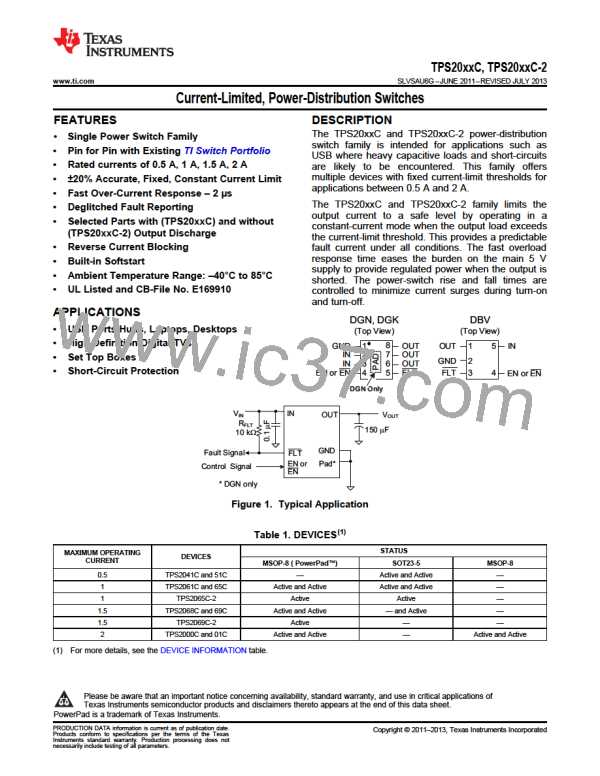TPS20xxC, TPS20xxC-2
www.ti.com
SLVSAU6G –JUNE 2011–REVISED JULY 2013
GND: 0.052in2 Total
& 3 x 0.018in vias
GND: 0.056in2 total area
& 3 x 0.018in vias
COUT
COUT
0.050in trace
CIN
0.050in trace
CIN
4 x 0.01in vias
VOUT: 0.048in2 total area
5 x 0.01in vias
VIN: 0.0145in2 area
& 2 x 0.018in vias
V : 0.00925in2
VOUT: 0.041in2 total
IN
& 3 x 0.018in vias
Figure 43. DBV Package PCB Layout Example
Figure 44. DGN Package PCB Layout Example
0.100 x 0.175
& 5 18 mil vias
0.08 x 0.250
0.15 x 0.15
0.185 x 0.045
& 3 18 mil vias
50 mil trace
0.100 x 0.060
& 3 18 mil vias to
0.07 x 0.08
inner plane 2
10 mil trace
Figure 45. DGK Package PCB Layout Example
The following procedure requires iteration because power loss is due to the internal MOSFET I2 × RDS(ON), and
RDS(ON) is a function of the junction temperature. As an initial estimate, use the RDS(ON) at 125°C from the
TYPICAL CHARACTERISTICS, and the preferred package thermal resistance for the preferred board
construction from the THERMAL INFORMATION table.
TJ = TA + ((IOUT2 x RDS(ON)) x θJA
)
(1)
Where:
IOUT = rated OUT pin current (A)
RDS(ON) = Power switch on-resistance at an assumed TJ (Ω)
TA = Maximum ambient temperature (°C)
TJ = Maximum junction temperature (°C)
θJA = Thermal resistance (°C/W)
If the calculated TJ is substantially different from the original assumption, estimate a new value of RDS(ON) using
the typical characteristic plot and recalculate.
If the resulting TJ is not less than 125°C, try a PCB construction and/or package with lower θJA
.
Copyright © 2011–2013, Texas Instruments Incorporated
Submit Documentation Feedback
17

 TI [ TEXAS INSTRUMENTS ]
TI [ TEXAS INSTRUMENTS ]